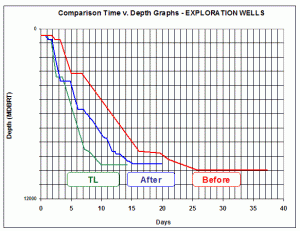Technical Limit Programme
Our first application of Technical Limit was whilst working for Amerada- Hess UK. The company had previously recognised, through the CRINE work on “‘Doubling the Value of Wells”
- Home
- Case Studies
- Technical Limit Programme
Case Details
Clients: Amerada- Hess UK
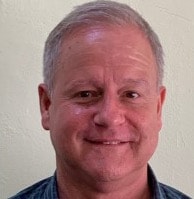
Work completed by:
Dave Taylor
Deepwater drilling performance programme specialist.
Location: UK
Let’s Work Together for Development
Call us directly or email us!
Address Business
Email our experts:
RESULTS AT AMERADA- HESS
Our first application of Technical Limit was whilst working for Amerada- Hess UK.
The company had previously recognized, through the CRINE work on “‘Doubling the Value of Wells”, that there was a substantial prize and set up the Well Value Team.
Two pilot schemes were run to prove the methodology, using offset wells as control. The first pilot was conducted on a Central North Sea Exploration well where there was a lot of offset data, including previous Hess wells with the same rig, one year previously. Using Rushmore metrics, it was the second-best E&A well performance that year.
The horizontal well pilot is shown below. Results were equally impressive.
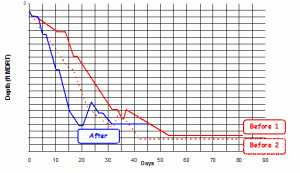
The link to the individual:
The previous graphs all show on a macroscopic scale what can be achieved. We were keen to devise some Key Performance Indicators that meant something to the folk doing a particular job. Taking a leaf out of Unocal Thailand’s book we chose Efficiency Factors.
These show how the time taken on a particular activity compares to what was done previously. To lake out the “time element”(an emotive issue with some people), we displayed this not as a time(in hours) but as an “inverse %-age” of the “Best”; the best being defined as line average of line two previous best times. We were able to devise a way of normalising line data and excluded trouble- time; we wanted to show how well we were doing in line absence of trouble, some of which is introduced by external influences.
The intention was to provide the crews with non-threatening performance information. We envisaged it being used in two distinct ways:
When a job went clearly better than last, the After Action Review would endeavour to identify the causes, so we could learn “The Best to Train the Rest”.
When a job didn’t go well, line team could immediately seek out causes when management see that a team is this focused, they tend to “back off” and give them the space to seek their own solutions. This is a potent empowerment technique, and increases intrinsic motivation.
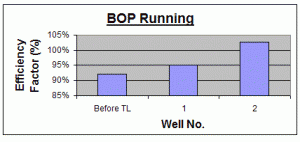
RESULTS AT BP Magnus
The BP Magnus Wells Team was keen to implement a Technical Limit programme, as part of a global company initiative.
Dave Taylor was taken on as full-time Technical Limit coordinator. Over the next 18 months the team worked themselves into best-in-class position. Improvements in safety performance went hand-in-hand.
The keys were:
A comprehensive training programme, using a half-day Awareness Seminar
Rigorous application of the Technical Limit methodology
Assignment of a resource (BP Drilling Engineer) to assist with wellsite aspects
Extensive communication, particularly feedback on follow-up
Supportive leadership (onshore and offshore)
Involving and gaining buy-in from as many people as possible
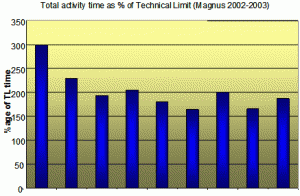
Consistently improving performance and closing the gap to Technical Limit
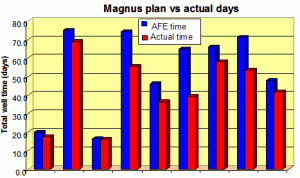
Delivered full year programme
The team vision was to btid capablity from within, with roles & responsibilities developed and coaching / training given. The team then took over running die programme themselves.
Dave set up rp² and provides adhoc support (mainly performance related workshops).
RESULTS AT BP NW Hutton
The BP NW Hutton Well Abandonment Team had seen the results of the Technical Limit programme used on nearby Magnus and were keen to implement a “light” version of it in their down-hole abandonment campaign.
Dave Taylor, and later rp², were taken on as part-time Technical Limit advisors part-way through the programme. The initial programme covered the wireline, coiled-tuning and cementing operations to abandon the well downhole.
Over the next few months, a programme was developed and rolled out. Once again, the team worked themselves into best-in-class position. Safety performance went hand-in-hand.
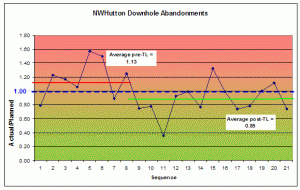
The graph above shows actual performance vs. planned with the red line showing average pre-TL and the green line showing average post-TL. Anything below one shows performance better than plan.
The campaign went so well that rp² were contracted for Phase 2, the Conductor Retrieval. Results from this were covered in a draft SPE paper, which is available via the authors.
RESULTS at BP Rhum and Clair
Rhum is BP’s first HTHP development in the North Sea. It is a Subsea tie back, with two new wells. Clair is the first platform development West of Shetland.
rp² was contracted to provide adhoc Technical Limit support, with a brief to help the teams set up their own Technical Limit programme with Workshop and operational support.
Both projects are ongoing. Key similarities in approach are:





